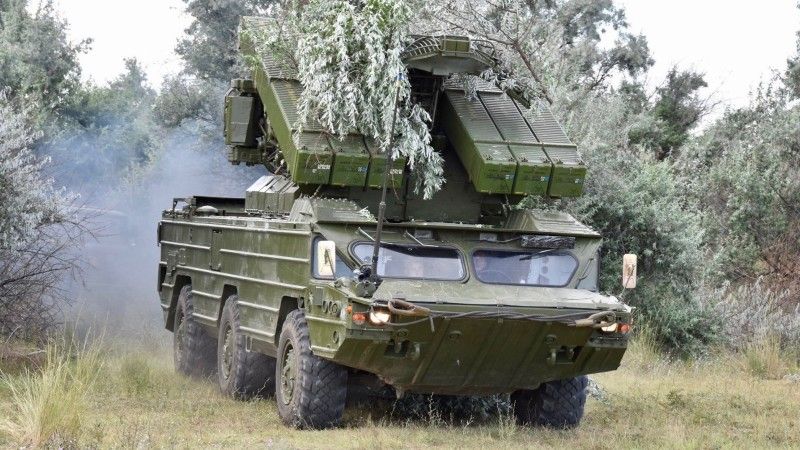Ukraine: Polish SAM Systems Used Against Shahed-136 UAVs [Commentary]

Photo. Armed Forces of Ukraine
“Poland has given us systems, that are used, along with Soviet-made missiles, by the Ukrainians to shoot down Iranian drones launched by the Russians. Thanks go to our Polish brothers!”, stated Valeriy Zaluzhny, via his social media channels, referring to crews trained in Poland, and operating the Polish equipment. This is yet another proof of armament delivery done “under the radar”. What equipment could have been mentioned here?
The release was published via social media channels by the general commander of the Armed Forces of Ukraine on 11th October. It mentions a battalion trained in Poland, and using Polish equipment, succeeding in downing 9 out of 11 Iranian Shahed-136 drones that the unit detected.
The information mentioning Ukrainian soldiers being trained in Poland, and using Polish missile systems, with Soviet-made effectors may be surprising. However, numerous pieces of equipment supplied by Poland to Ukraine may not have been officially mentioned. Usually, the transfer was unveiled when footage of that equipment was recorded on the frontline, during deliveries, or when the Ukrainians themselves decided to make these facts public. This seems to be the case here as well.
Not many mentions were made, regarding the Polish air defence systems, apart from the famous Piorun MANPADS. The cryptic information on “Polish launchers with Soviet-made missiles” may point to three possible weapons systems: 2K12 Kub, Neva-SC, or Osa-AKM-P SAMs. The recent information on the neutralization of the Shahed-136 drones points to the plausible use of the latter systems.
During a conference held by the IISS in Washington, the Defence Attaché at the Ukrainian Embassy, Gen. Maj. Boris Kremienietsky announced that ZSU-23-4 Shilka or Gepard AAA systems, and Osa SAM systems are among the primary assets used in the neutralization of the Iranian drones - they are also among the most lethal ones used in that role.
These systems are highly autonomous, and also lethal when used against low-flying targets. The low cost of 23/35 mm AAA rounds is also relevant here. Nonetheless, the Osa system’s effectors are also relatively inexpensive, especially when compared to other SAMs.
This stems from the system concept, where the missile is controlled via commands fed from the launcher which means that the missile has no complex and costly guidance unit of its own. Furthermore, the Osa SAM remains fully autonomous. No extra sensors are required to engage the targets. The Soviet variant features a target detection radar providing 360-degree coverage, and another radar used for missile guidance.
More importantly, the Polish launchers have received the Osa-AKM-P upgrade. Several analogue subsystems underwent digitalization, and radars have been modernized and complemented with optoelectronics featuring thermal imagers and video trackers. The C2 suite has been upgraded as well. That resulted in a major improvement of the Osa's combat capability, also allowing for the neutralization of air threats with the use of passive sensors. Still, the Osa-AKM-P SAM system utilizes the legacy missiles, with commands-based guidance. This renders the system in question unable to engage multiple targets at once.
At the same time, that means both the Polish, as well as the Ukrainian missile stockpiles can be used here. The Ukrainians may also use missiles captured during the fights, as Osa is also still operated by the Russian Army, and some systems were taken over during the operations - along with the munitions.

Summing up, it is highly probable that Ukraine received at least one squadron of Osa-P systems from Poland. The crews have also undergone comprehensive training in Poland, as the rumours seem to suggest. This is plausible, as the role assigned to those systems - directly defending mobile/stationary units - would soon be taken over by the new Narew SHORAD solution. The first battery has already been received by the 18th Anti-Aircraft Regiment, as a part of the "Little Narew" programme. Another battery would be commissioned in early 2023, in the 15th Anti-Aircraft Regiment based in Gołdap.
Poland originally operated 64 Osa-P SAMs, in anti-aircraft regiments of the 11th "Lubuska" Armoured Cavalry Division, and the 12th "Szczecińska" Mechanized Division (each of the regiments included, by default, two squadrons equipped with this system). A few years back the Polish industry presented a concept assuming the integration of the Osa-P system with the German IRIS-T missile (a lighter derivative of the IRIS-T SLM effector). However, the concept was not pursued.

WIDEO: Defence24 Days 2025: Premier Defence & Security Conference in CEE